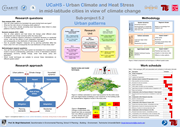Research Module 5.2 Urban Patterns
General
This project aims at modelling the interrelations of urban patterns and heat stress. Heat-stress risk within a city is a function of urban climate, the vulnerability of city dwellers and the detailed physical urban structure. The building density, structure and form as well as the availability of green spaces influence heat storage in urban neighbourhoods in great measure as recent studies proof. Mitigation concepts by planning are starting to face heat-stress risks currently. However, little is known about the effectiveness of those measures. Complex individual measures of adaptation to heat-stress risks in form of behavioural change regarding housing decisions are barely understood and need to be addressed. Research Module 5.2 focuses on utilizing different model techniques to simulate the interaction of urban patterns, heat-stress risk and measures of adaptation and mitigation on different spatial scales.
- The structure of the urban environment depicts a crucial component for the characterisation of heat-stress risk. Consequently, the driving forces generating the dynamic behaviour of the urban environment have to be described explicitly.
- Urban patterns are characterised by different urban structure types, which imply different conditions of heat storage and consequently a varying vulnerability regarding heat stress. Urban green spaces describe valuable cooling elements within the urban system and are significant for mitigation to heat stress in disadvantaged neighbourhoods.
- City dwellers especially those of higher heat stress receptivity adapt to heat stress by changing their housing preferences. Besides the perception of heat stress information plays an important role for the residential relocation.
- The combination of different model techniques offers greater insight in system functionality and system behaviour regarding heat stress and reveals a model comparison in terms of strengths and weaknesses.
Collaboration within Research Links (RL)
| 480 | Specific vulnerable groups |
| 490 | Urban climate projections |
| 520 | Present-day heat-stress hazards, vulnerabilities and risks |
| 530 | Effectiveness of actions for reducing heat-stress risks |
| 540 | Efficiency of actions for reducing heat-stress risk |
